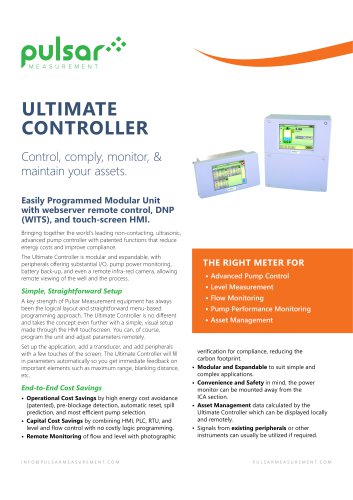 Website:
Pulsar Measurement
Website:
Pulsar Measurement
Catalog excerpts

dBR RADAR TRANSDUCERS FMCW Radar dBR sensor for non-contacting level and volume measurement Flexibility, Choice, & Accuracy Like No Other. The dBR Radar transducer range from Pulsar Measurement is a compact FMCW Radar sensor that offers high accuracy, repeatable level measurement, and compatibility with Pulsar Measurement’s full range of controllers. The introduction of the Radar sensor to the transducer range means that customers of Pulsar Measurement now have a choice of technology at their fingertips — without having to make any compromises in terms of functionality. Features & Benefits Radar and non-contacting ultrasonic measurements are complementary technologies — measuring level by signal analysis but excelling in different situations. Radar technology is preferred where there is a variation in temperature or changes in gas composition, and extremes of fog, haze, mist, or rain. The dBR Radar transducers feature Frequency Modulated Continuous Wave (FMCW) technology with a maximum 16 m (52.5 ft) range and accuracy of ± 2 mm (0.08 in). FMCW radar technology offers significant advantages over other pulsed radar systems as it offers higher resolution, better signal to noise ratio, and better target discrimination. The dBR sensors are IP68 rated and certified for external installations, offering class-leading performance in accuracy and repeatability with a short-range blanking distance. The compact size of the sensor allows for installation in cluttered, confined, or crowded spaces. THE RIGHT METER FOR • Foamy Applications • Application’s Subject To High Electrical Noise • Atmospherically Volatile Applications • Chemical Dosing Plants & IBC’s • Digester Level Monitoring Retrofittable with All Pulsar Measurement Controllers This series of transducers are compatible with existing Pulsar Measurement controllers that are already installed and used in the field, such as the Ultra 4 and Ultra 5, meaning that sites can retrofit a radar sensor with their existing applications, redeploy other Pulsar Measurement equipment across a wider range of applications for maximum flexibility, or test the performance of different measurement technologies without having to significantly reconfigure the device.
Open the catalog to page 1
DBR RADAR TRANSDUCER SERIES When Should You Consider Radar Technology? There isn’t a lot of difference between ultrasonic and radar technology, however, there are some applications where radar is better suited. Longer Range Open Channel Flow MCERT Applications MCERT schemes are independent schemes designed to provide a framework for businesses to meet quality requirements. Under Class 1 certification, the first three most accurate devices listed are ultrasonic, with a 0.04% combined accuracy, compared to radar on the same scheme having class 2 certification with a combined accuracy of...
Open the catalog to page 2
Technical Specifications PHYSICAL Model Options: Sensor Body Material Sensor Body Dimensions Measurement Range Beam Angle Cable Lengths Standard: 5 m, 10 m, 20 m, or 30 m (16.4 ft, 32.8 ft, 65.6 ft, or 98.4 ft). Optional: up to 150 m (492 ft) in 10 m (32.8 ft) increments Maximum Separation Mounting Options Mounting Connection Enclosure Protection Max. & Min. Temperature (Electronics) Process Pressure Complies with EN61326-1:2013 for emissions and immunity Complies with EN302-729:2016 for radar emissions and immunity ATEX Zone 0 (Ex ia): Ex II 1 G Ex ia IIC T4 Ga Ta = -20 ºC to +80 ºC, Ex II...
Open the catalog to page 3
Radar or Ultrasonic? The hoice is yours. Whatever you are measuring or trying to achieve, ultrasonic measurement will achieve what you’re aiming for 95% of the time. But for those applications that are a little trickier than first thought, radar will help provide a solution. One thing that is crucial to the outcome of your measurement is ensuring that you choose a controller that is retrofittable with both technologies, so that when the needs of your application change, your system changes with you. • Penetrates non-metallic containers • Unaffected by fog, haze, mist, or rain • Unaffected...
Open the catalog to page 4All Pulsar Measurement catalogs and technical brochures
-
REFLECT 2-wire Radar Sensor
4 Pages
-
MICROFLOW
2 Pages
-
FLOW PULSE
2 Pages
-
Quantum 3 Sales Brochure
4 Pages
-
Quantum 2 Sales Brochure
4 Pages
-
IMP Sales Brochure
4 Pages
-
IMP Lite Sales Brochure
4 Pages
-
IMP I.S. Sales Brochure
4 Pages
-
Blackbox Level Controller
4 Pages
-
The Ultimate Controller
4 Pages
-
FlowCERT Sales Brochure
4 Pages
-
dB Ultrasonic Sensors
4 Pages
-
Ultra 4 Sales Brochure
4 Pages
-
SFM 6.1 Slurry Flow Meter
4 Pages
-
Open Channel Flow Monitors
2 Pages
-
ISM 5.0 Insertion Magmeter
4 Pages
-
DFS 5.1 Doppler Flow Switch
4 Pages
-
Model DFM 6.1
4 Pages
-
AVFM 6.1
4 Pages
-
TTFM 6.1
4 Pages
-
PULSARGUARD 2010 SERIES
2 Pages
-
PULSARGUARD 2001 SAND SENSOR
4 Pages











































